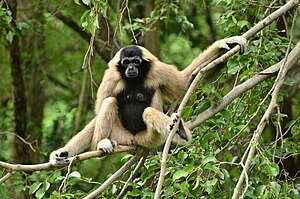Cap gibbon
| Cap gibbon | ||||||||||||
|---|---|---|---|---|---|---|---|---|---|---|---|---|

female cap gibbon |
||||||||||||
| Systematics | ||||||||||||
|
||||||||||||
| Scientific name | ||||||||||||
| Hylobates pileatus | ||||||||||||
| ( Gray , 1861) |
The Pileated ( Hylobates pileatus ) is a primate of the family of gibbons (Hylobatidae).
features
Exact data on body measurements and weight are unknown. Male and female cap gibbons have very different coat colors, which is why early researchers described them as separate species. Adult males are almost completely black with the exception of a whitish face ring (sometimes just a white eyebrow band or a few long, grayish fringes on the temples). The hands, feet and the genital tuft are white. Females and juveniles are silvery-gray or yellow-brown with a black cap on the head, black cheeks, a black chest (with age the black coloration expands to the insides of the limbs) and a white face ring. In both sexes, however, the hair on the head is directed backwards like a fan.
distribution and habitat
The distribution area of the cap gibbons extends over southeast Thailand , western Cambodia and the extreme southwest of Laos , the Mekong forms the eastern border. They probably also occurred earlier in South Vietnam .
Cap gibbons are inhabitants of moist, seasonal, evergreen mixed deciduous forests at altitudes of up to 1200 m in Thailand and 1500 m in Cambodia.
Way of life and reproduction
The cap gibbon is diurnal tree dweller. The groups spend most of the day resting. They sleep an average of 16 hours a day. The cap gibbon is more shy and harder to spot than the white-handed gibbon .
Cap gibbons are predominantly monogamous, but polygamous groups in the hybrid zone with the white-handed gibbon in the Khao Yai National Park in Thailand have also been detected. Territories are 15 to 50 hectares in size. Male cap gibbons, unlike other gibbon species, are mainly responsible for defending the territory and leading the group. Mixed groups of cap and white hand gibbons with two adult females have been observed in Thailand. The average size of a group in Thailand is four individuals. The population density in Thailand is generally low with an average of one group per km 2 and only higher in remote mountain regions. In the Cardamom Mountains in Cambodia there are one to two groups per km 2 . Information on population density in Laos is not known.
The menu of the cap gibbon is very similar to that of the white-hand gibbon. Fruits (71%), flowers (15%), young shoots (2%) and young leaves and insects are eaten.
Infants are cream colored until they have silvery tan fur at one year old. During puberty, the coat of the males changes to the typical male coat color. Sexual maturity at six to eight years. Life expectancy is up to 39 years.
Hybridization between the cap gibbon and the white-handed gibbon occurs on the upper reaches of the Takhong River over 120 km northeast of Bangkok . These hybrids used to be quite common in zoos. They are brightly colored at birth and darken with age. Among the 61 gibbon groups in the hybrid zone, at least 18 included hybrids, including backcrossed animals. However, humans have largely destroyed a large part of the 120 km long hybrid zone by creating rice fields. The chants of the hybrid contain elements of different types of gibbon. In certain characteristics the song of the male hybrids resembles that of the black-handed gibbon ( H. agilis ). It also contains three-part elements that are not present in the chants of the parents, so that the chants of the hybrids cannot have been created by simply combining those of the parents. The calls of the female hybrids resemble those of the silver gibbon ( H. moloch ). In addition, a male hybrid with the western crested gibbon ( Nomascus concolor ) has been detected.
threat
The cap gibbon is classified by the IUCN as "endangered" (highly endangered). It is endangered by the progressive loss of habitat due to habitat fragmentation and destruction. Many populations are isolated in small regions in mountain forests. Occasionally the species is hunted for human consumption. Many Cambodian populations do not live in nature reserves and are at risk from deforestation, agriculture, hydropower plants and new human settlements. In Thailand, all of the remaining populations are found in nature reserves, but hunting in these areas is still not under control. The cap gibbon is represented in a total of 25 nature reserves. In 2005 more than 35,000 individuals lived in Cambodia and 13,000 to 14,000 in Thailand. In Cambodia, the cardomans are the most important area with 20,000 animals. In Thailand there are 12,000 specimens in four initially protected areas and 1,000 to 2,000 in 15 heavily fragmented nature reserves. Numbers for Laos are not known, but are believed to be lower because of the small area of distribution in the country.
Individual evidence
- ↑ International Zoo Yearbook 1970, p. 257.
literature
- Thomas Geissmann: Comparative Primatology . Springer, Berlin 2003. ISBN 3-540-43645-6 .
- Thomas Geissmann: Systematics of the Gibbons . In: Zeitschrift des Kölner Zoo 37, 1994, pp. 65–77.
- Thomas Geissmann: Gibbon systematics and species identification . In: International Zoo News 42, 1995, pp. 467-501.
- DE Wilson, DM Reeder: Mammal Species of the World . Johns Hopkins University Press, 2005. ISBN 0-8018-8221-4 .
- Russell A. Mittermeier, Anthony B. Rylands, Don E. Wilson: Handbook of the Mammals of the World. Volume 3: Primates. Lynx Edition, Barcelona 2013, ISBN 978-84-96553-89-7 , p. 785.
Web links
- Information from the Gibbons Research Lab. (English), with photos and sound files
- Hylobates pileatus in the endangered Red List species the IUCN 2010. Posted by: Brockelman, W. et al , 2008. Accessed February 27 2011th

